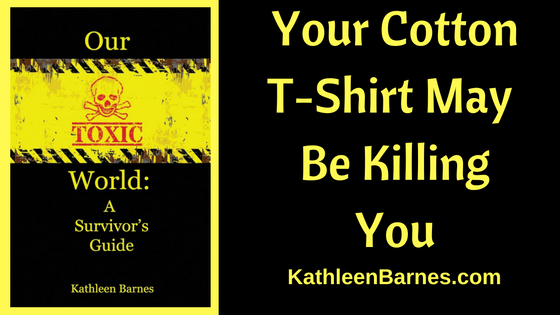Excerpted from Our Toxic World: A Survivor’s Guide by Kathleen Barnes
We all love our cozy cotton T-shirts, shirts, pants, underwear, towels and sheets. They feel comfy and safe.
The cotton industry fosters that illusion with its “fabric of our lives” campaign, pushing the notion that this “natural “ fiber is healthy and creates happiness.
Nothing could be further from the truth.
Cotton is the most intensive pesticide-use crop in the world, accounting for approximately 25% of all insecticides used worldwide, although cotton is grown on only 3% of the world’s farmland.
Five of the top nine pesticides used on cotton in the U.S (cyanide, dicofol, naled, propargite and triflurin) are known cancer-causing chemicals. All nine of the top pesticides used on cotton crops in the U.S. are classified by the EPA as Category I or II, the most dangerous categories of chemicals.
Cotton weevils are resistant to pesticides
The reason for the intensive pesticide use on cotton is that weevils and other cotton pests develop immunity to these chemicals very quickly, in about five or six years. It takes 8 to 10 years and approximately $100 million to develop new pesticides for use on cotton, so the new chemicals are ever more toxic and quickly become obsolete.
The cotton toxic waste is everywhere
In California, it has become illegal to feed the leaves, stems, and short fibers of cotton known as ‘gin trash’ to livestock, because of the concentrated levels of pesticide residue. Instead, this gin trash is used to make furniture, mattresses, tampons, swabs, and cotton balls. The average American woman will use 11,000 tampons or sanitary pads during her lifetime.
According to the Organic Consumers Association, about 80% of all the cottonseed and almost all the gin trash go right into feed for dairy cows and into our milk. The other 20% of the cottonseed is made into oil, meal and cake and winds up in many different junk foods.
Toxic substances are absorbed by skin
Cotton clothing places some of these pesticides right on your skin, which is the largest and most absorbent organ of your body. Not only is your skin in contact with that T-shirt, underwear or pants for most of the day, if you’re sweating, the increased body heat can accelerate absorption of the pesticide residues in the fabric.
The problems with clothing production don’t stop in the field. During the conversion of conventional cotton into clothing, numerous toxic chemicals are added at each stage— silicone waxes, harsh petroleum scours, softeners, heavy metals, flame and soil retardants, ammonia, and formaldehyde— to name just a few.
Other toxic clothing
Other common types of clothing aren’t much better. Clothing made from synthetic fibers like acrylic, nylon and polyester is coated with formaldehyde finishes that continuously give off minute plastic vapors as the fabric is warmed against your skin, causing allergies and breathing problems from the airborne particles and unknown effects of formaldehyde in contact with large skin surfaces.
It’s really no surprise that a recent study of the cord blood of 71% of newborn babies shows extensive exposure to toxic substances passed to the baby through the placenta, including some of those used in cotton production. Worse yet, the majority of these toxic substances are carcinogenic, 75% are toxic to the brain or nervous system and 72% cause birth defects or abnormal developments.
Healthy clothing
Clothing that is made from 100% organic cotton, silk, linen, hemp, or tencel (made from natural cellulose found in wood pulp) will be free of these toxic residues.
If all new clothing isn’t in your budget, you can also buy used clothing, which may outgas less and the continued washing may have removed some of the residues.
If none of these works for you, wash any new clothing several times before you wear it.
Resources:
http://www.ecochoices.com/1/cotton_statistics.html
http://www.organicconsumers.org/clothes/224subsidies.cfm
http://www.ewg.org/reports/bodyburden2/execsumm.php








Sharing your post on my Facebook. I am vegetarian, and made the commitment last year to only by OG cotton clothing. Thanks so much for your info. We need to do research on whether older cotton clothing is actually safer. The fibers may release worse after aging. And would love some stores that carry OG to be represented.
Imagine your T shirt killing you? Very disturbing. What else id disturbing is the 100% organic t shirts can cost up to fifty dollars. Just looked it up. Maybe we can all just run around naked:)
In any case I love your blog. It is always informative. Can not wait for your new book.
I can’t believe how toxic cotton can be and to know it’s in so many things I wear and my family wears. This is an excellent article and I am grateful for opening my eyes. I have shared your article on my blog because people need to be aware and make a choice.